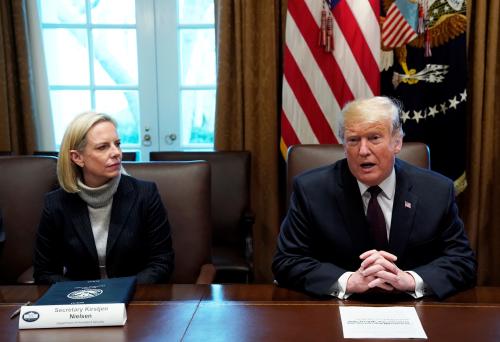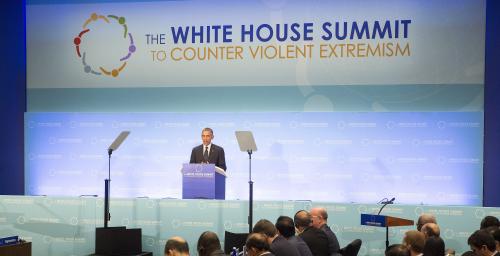The president is right: Countering violent extremism or “CVE” in the United States does need improvement. However, focusing it exclusively on Islamic extremism, as he reportedly plans to do, does not constitute one. Rather, the focus should be on learning from past CVE mistakes and successes to develop better-informed policies and programs that reduce rather than exacerbate the threat.
Although the Obama administration deserves a lot of credit for elevating CVE and devoting more attention to identifying early signs of radicalization and intervening before it leads to violence—as a policy priority—its domestic CVE record was mixed.
A collection of various non-military measures aimed at reducing support for violent extremism at home, were lumped under the “CVE” umbrella. This was based on the premise that there are a range of law enforcement and non-law enforcement interventions that can prevent individuals who are at risk of radicalization to violence or are already celebrating terrorist propaganda from becoming violent.
The February 2015 White House CVE summit focused increased attention and enhance support for community-led CVE work particularly those that involve cities and community leaders and other non-law enforcement professionals. Less than a year later, then-Department of Homeland Security (DHS) Secretary Johnson created the CVE office—with the antiseptic name: the “Office of Community Partnerships”—to sustain this part of the efforts that attracted the ire of the Trump team—to sustain. The $10 million DHS CVE grants program to support community-level programs, which has come under fire from the Trump team, soon followed.
Stumbling blocks
Somewhat ironically, the handful of city and community-level programs that have been developed to counter violent extremism have refused to use the “CVE” label on those initiatives for fear of the community backlash. Instead, they preferred labels such as “building community resilience” or “preventing targeted violence.” In fact, the term is rarely used outside the Beltway.
Particularly in the aftermath of the Boston Marathon bombing in 2013, the National Counterterrorism Center (NCTC), the Department of Justice (DOJ), and the FBI ramped up their CVE work, some focused on engaging communities, something that DOJ and FBI have long histories of doing—generally effectively—outside of the CVE context. While most of these agencies claimed to be looking at “all forms” of violent extremism, the reality was that much of the focus was related to just one: radicalization and recruitment to jihadi violence.
Some communities perceived the FBI as the enemy, however, citing the alleged use of undercover agents or informants to entrap young Muslims who might have voiced sympathy for ISIS and accusations of coercing people to spy on their Muslim-American friends. As a result, at times, FBI suffers a trust deficit when it comes to CVE efforts with precisely the communities that the federal government most needs as partners.
The FBI has also stumbled in its attempts to move beyond the traditional law enforcement tool kit (i.e., surveillance, investigation, and arrest) for preventing radicalization to violence. In early 2016 it launched its “Don’t Be a Puppet: Pull Back the Curtain on Violent Extremism” inter-active website to teach teens how to recognize violent extremist messaging and become more resistant to self-radicalization and possible recruitment both on and offline. This program should have been developed and rolled-out by the Department of Education or a suitable NGO. Predictably, it was met by strong criticism from the American Federation of Teachers and civil rights and community groups, which said it would lead to increased ideological policing and surveillance efforts that will have a chilling effect on schools and immigrant communities.
Last fall, after significant pushback from Congress and civil rights and Muslim-American advocacy groups, the FBI scrapped its ill-fated Shared Responsibility Committees (SRC), which were designed to bring together law enforcement officers, religious leaders, mental health experts, and others to intervene with vulnerable people before they turn violent and in lieu of prosecution.
[T]he FBI… deserves credit for recognizing the need to develop new tools to deal with the range of violent extremist challenges it is now facing.
While the FBI has been criticized at times for trying to do too much in the CVE space, it deserves credit for recognizing the need to develop new tools to deal with the range of violent extremist challenges it is now facing. The SRC false start has as much to do with an inadequate process in Washington for vetting and testing CVE ideas before implementation as it does with FBI impatience or overreach.
Unlike the FBI, the Bureau of Prisons can be faulted for not doing enough. Despite the growing number of people sent to federal prison for non-violent terrorism charges (over 300 since 9/11, with more than 90 individuals charged with mostly non-violent ISIS-related offenses, and 40 or so to be released in the next two to four years), the United States, unlike many countries in Europe (and increasingly beyond), has yet to put in place tailored plans for their rehabilitation inside jail or reintegration once they are released.
In addition to this lacuna, federal investigators and prosecutors continue to have limited options other than arresting and prosecuting young people suspected of having travelled or seeking travel to support the Islamic State, but who are judged not to pose a security threat and for whom a 10 to 20-year jail sentence might risk further radicalization. This, despite an increasing awareness, including within the FBI and DOJ, that alternatives to criminal prosecution and incarceration, in certain circumstances, can help facilitate the cooperation of family, friends, and other members of vulnerable communities who may be reluctant to cooperate with law enforcement if they know that any outreach might put their loved one in a prison cell. All CVE eyes are on a federal judge in Minneapolis, who is toying with the possibility of issuing a lighter sentence to young Somalis accused of wanting to travel to join the Islamic States, combined with participation in a program that focuses on reintegration and reconciliation.
Moreover, unlike in Australia, Canada, and across Europe, few, if any, non-law enforcement alternatives for families and other members of the community to use to report concerning behavior exist. This reduces the likelihood that they will bring signs of radicalization to violence to the attention of anyone. And interventions, such as counseling to prevent violence before law enforcement is needed, remain quite limited and entirely ad hoc.
On top of the traditional alphabet soup of national security agencies, domestic CVE work sought to involve non-security actors in the federal government—e.g., the Departments Education and Health and Human Services—as well as state and local governments. Perhaps most importantly, communities and the social workers, teachers, health professionals, families, and religious leaders that live and work in them were increasingly being encouraged to get involved.
However, in addition to the well-documented obstacles that the Washington-driven CVE program faced in broadening community involvement, the effort has yet to draw more than token participation from possible non-law enforcement Washington contributors. They continue to be reluctant to sign on to what they perceive to be a security agenda that lacks broad-based support among their traditional constituents—teachers, social workers, health professionals—in communities around the country. However, state and local health officials, for example in Los Angeles and Boston, are increasingly becoming involved in community efforts to prevent violence, including violent extremism, but not labeled as or exclusively focused on CVE.
Lack of coordination and a clear division of labor among the various federal agencies involved in CVE has often confused state and local, as well as international, partners, and led to duplication, thus hampering the wider efforts. The DHS-led federal CVE task force established in 2016, albeit with few dedicated resources, was charged with improving coordination at the federal effort and facilitating engagement with state and local actors across the country. Ironically, Washington slapped the “CVE” label on the new mechanism despite the awareness that such a label could hamper its ability to perform two of its more important tasks: getting non-security federal actors more involved and catalyzing more local programs.
The upshot on CVE over the past few years is that despite the high-level attention—and good intentions—from the executive branch, the effort has floundered for various reasons. These include: lack of resources (in addition to the paucity of federal funds, private funding to catalyze community-led efforts have been scarce); inconsistent leadership and coordination at the federal level; an approach led by law enforcement agencies that has made it difficult to bring on board critical federal agencies and build trust with local communities, leading to an overly Beltway-centric approach to empowering local communities; a conflation federal government-led and community-led initiatives; and a lack of guidance and support for law enforcement actors to pursue alternatives to arrest, prosecution, and incarceration of suspected terrorist offenders.
None of these are insurmountable obstacles and stopping people from being radicalized to violence is too important to the security of all Americans to not try to overcome them.
With the increased attention that “CVE” in the United States has received over the past few years, there is no shortage of practical proposals that could, if implemented, make a difference.
What can be done?
So, what could be done? With the increased attention that “CVE” in the United States has received over the past few years, there is no shortage of practical proposals that could, if implemented, make a difference. Here are some suggestions:
1. More local control. Get the federal government out of the business of trying to build community partnerships linked to CVE. Local, multi-disciplinary prevention-focused programs in Boston, Los Angeles, Minneapolis, and Montgomery County in Maryland have emerged often despite rather than because of Washington’s involvement. Nevertheless, cities and communities have continued to look to Washington for guidance, funding, and other support, which has been slow to materialize and has come with political or bureaucratic baggage. This should stop. Particularly in today’s political climate, it is unlikely that communities will welcome or trust Washington’s continued involvement in this area. Further, any support that Washington might provide—funding, expertise, guidance, and best practices—could be found from other sources, especially if the private sector and foundations step forward to support this important work, including by catalyzing the development of an NGO-led national network dedicated to preventing radicalization in the United States.
Going forward, cities, many of which are led by mayors who reject the anti-immigrant and anti-Muslim rhetoric coming out of the White House, should chart their own course. They should refuse to cooperate with any federal “CVE” effort focused on “Islamic extremism.” Instead they should develop initiatives framed around issues such as “preventing targeted violence” or “building resilience and social cohesion” that build trust and are most likely to resonate within their community. As we have seen, such an approach, is more likely to attract resources and other support from a coalition of local businesses, non-profits, leaders, institutions, and professionals.
2. Mind the gap. Close the most glaring gaps in United States “CVE” efforts: a lack of “off ramps” and rehabilitation/reintegration options. Attention should focus on catalyzing a dedicated effort to develop multidisciplinary “off-ramp” programs for those being targeted by or celebrating terrorist propaganda, including by providing clear federal guidelines for referrals by community members to law enforcement. The development of clear processes to allow individuals and organizations to work in the intervention space without fear of prosecution should also be a priority. Further, there is clear need for programs and strategies within federal courts for rehabilitating and reintegrating suspected or convicted terrorists. Presently, there are no federal policies or programs in the United States (while models do exist in other countries) to address the rehabilitation and reintegration of violent extremist offenders or to guide and support alternative sentencing.
3. Involve leaders at all levels. Convene leaders from national-level institutions, associations, and networks outside of the security/law enforcement sphere (to include mayors, teachers, universities, public health professionals, and religious, and inter-faith groups) to formulate initiatives for each of them to contribute to a “whole of society” effort to prevent young people in the United States from being radicalized to violence, without these platforms having to associate themselves with federally-led “CVE” efforts. The goal would be to create a range of reinforcing networks outside of the law enforcement sphere for preventing violent extremism and allow the U.S. government to draw on their expertise and experience as we work to build the capacity of other countries in this area.
4. Expand cross-disciplinary research. An invigorated cross-disciplinary research effort that leverages social scientists (including psychologists, sociologists and criminologists) at universities around the country, as well Health and Human Services and Centers for Disease Control and Prevention, can help both government and non-government stakeholders to get smarter about how to prevent violent extremism (e.g., looking at what makes individuals and communities resilient to this and related forms of violence and the role that mental health issues play in violent extremism). Ongoing DHS and DOJ research on what drives violent extremism and what works and doesn’t to address it should be part of this expanded effort.
5. Expand training and resources for law enforcement. Additional training and resources should be provided to organizations like DHS, FBI, as well as other relevant training and exercises for state and local law enforcement on preventing radicalization, with more emphasis placed on promoting a “whole of community” concept in order to enhance law enforcement’s capabilities in this area. Particularly given the current political climate, providing local police with the skills and knowledge to engage effectively with rather than alienate community members should be a top priority.
What is needed now?
At the end of the day, however, given how partisan and ideological discussions about CVE in this country have become, the space for any practical proposals to emerge and garner support from pragmatists in Congress, as well as state, local, and community actors, is extremely limited.
To help create this space, Congress should establish a bipartisan commission that includes strong representation from federal, state, and local actors, from both security and non-security professionals, and community and private sector leaders. This commission would mandate to review efforts to prevent homegrown, jihadi-linked and other violent extremist attacks at home and to make recommendations on new policies and programs both inside and outside the Beltway, in order to prevent another Orlando or San Bernardino or an attack like one that took place in a Quebec City mosque earlier this month.
The partisan divide has impeded efforts to develop a comprehensive, smart, and sustainable national plan to prevent violent extremist attacks in the United States.
Such a commission would help find middle ground between the generally polarized, and often politicized conversation that has characterized debates around CVE in this country. The partisan divide has impeded efforts to develop a comprehensive, smart, and sustainable national plan to prevent violent extremist attacks in the United States. The congressionally-mandated, bipartisan 2006 Iraq Study Group might serve as a useful precedent. That group’s report assessed the state of the war in Iraq and offered fresh policy recommendations, many of which were in fact accepted by the White House. It was seen as critical to building bipartisan support for a strategy to end that war.
Such a commission should include representatives from all key constituencies outside of the national security establishment that has historically been in the CVE drivers’ seat in Washington. If we want universities, governors and mayors, public and mental health officials, social scientists, religious and other community leaders, CEOs, and private foundations to be invested in the plan and help implement it, they need to be at the design table.
Unfortunately—but predictably—instead of taking a serious and fresh look at the strengths and weaknesses of the entire CVE effort at home, and seeing what lessons can be learned from more advanced CVE work in a growing number of countries and cities around the globe, the Trump team has focused on only a single element of it and proposed changes, which appear to include picking perhaps the only label that is more offensive to American-Muslims than “CVE.” As a result, rather than taking steps to strengthen the extra layer of defense that “CVE” was intended to provide, Trump’s superficial, short-sighted, and highly politicized approach will make all Americans more vulnerable and less safe.










Commentary
Fixing CVE in the United States requires more than just a name change
February 16, 2017